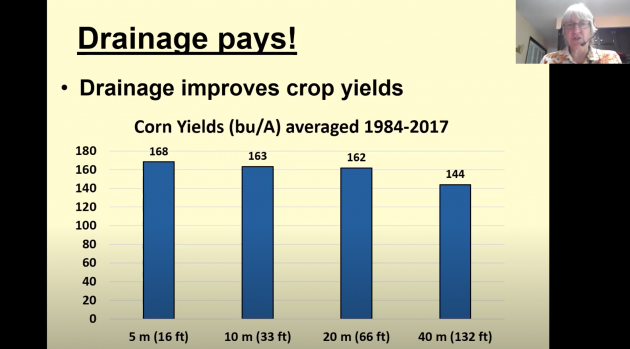
News
Drainage Management Systems
Watch: ‘Drainage pays’- Executive summary of long-term research study
August 17, 2020 By Drainage Contractor
In a five-minute video, Eileen Kladivko, professor of agronomy at Purdue University, provides an executive summary for the Southeast Purdue Agricultural Center’s (SEPAC) long-term drainage study.
The study took place in southeast Indiana for a 35-year period.
The study’s key takeaways show that installation of tile drainage is a good long-term investment in the field. Drainage improves timeliness of fieldwork by 1 to 15 days, corn yields, cover crop growth and it enables other conservation practices to work better.
Field work timeliness
Kladivko shares that undrained, control plots were delayed by one to 15 days compared to the narrowest drain spacing. Drainage improved the timeliness of field work, and more timely access to a field is a major benefit to most farming operations.
Improving crop yields
Between 1984 and 2017, corn yields on the drained plots were higher than the control plot. Kladivko shows how the controlled plot averaged 144 bushels per acre (bu/ac), whereas drained fields (of varying spacing) consistently averaged above 160 bu/ac. Improved yields provide economic benefit to farmers.
Improving cover crop growth
Kladivko’s research shows that drainage improves cover crop growth and also allows other conservation practices to work more effectively.
Cover crops grown on a tiled field produced about 3,100 pounds (lbs.) of biomass per acre, compared to only about 700 lbs. of biomass per acre on the untiled field. The untiled field was only able to produce a fourth of the biomass amount the tiled field produced.
Drainage’s effect on water flow and quality
The research demonstrated that the closer the drain spacing was, the more water and nitrates were lost in the tile drainflow. However, Kladivko notes that “losing water” is the point of narrower spacing because farmers want to see their fields drained faster. The issue is the loss of nitrogen, which is valuable for plant growth but detrimental to water quality.
Over the duration of the 35-year study, nitrogen practices changed and Kladivko shows how introducing cover crops and switching to a corn-soybean rotation (versus continuous corn) significantly reduced nitrate losses from tiles.
Summary
Kladivko sums up her research by concluding that the long-term improvement in cash crop yields, cover crop growth, and effectiveness of other conservation practices make tile drains a good investment.
Print this page
